实验三
1、实验任务1
button.hpp
1 #pragma once 2 3 #include <iostream> 4 #include <string> 5 6 using std::string; 7 using std::cout; 8 9 // 按钮类 10 class Button { 11 public: 12 Button(const string &text); 13 string get_label() const; 14 void click(); 15 16 private: 17 string label; 18 }; 19 20 Button::Button(const string &text): label{text} { 21 } 22 23 inline string Button::get_label() const { 24 return label; 25 } 26 27 void Button::click() { 28 cout << "Button '" << label << "' clicked\n"; 29 }
windows.hpp
1 #pragma once 2 #include "button.hpp" 3 #include <vector> 4 #include <iostream> 5 6 using std::vector; 7 using std::cout; 8 using std::endl; 9 10 // 窗口类 11 class Window{ 12 public: 13 Window(const string &win_title); 14 void display() const; 15 void close(); 16 void add_button(const string &label); 17 18 private: 19 string title; 20 vector<Button> buttons; 21 }; 22 23 Window::Window(const string &win_title): title{win_title} { 24 buttons.push_back(Button("close")); 25 } 26 27 inline void Window::display() const { 28 string s(40, '*'); 29 30 cout << s << endl; 31 cout << "window title: " << title << endl; 32 cout << "It has " << buttons.size() << " buttons: " << endl; 33 for(const auto &i: buttons) 34 cout << i.get_label() << " button" << endl; 35 cout << s << endl; 36 } 37 38 void Window::close() { 39 cout << "close window '" << title << "'" << endl; 40 buttons.at(0).click(); 41 } 42 43 void Window::add_button(const string &label) { 44 buttons.push_back(Button(label)); 45 }
task1.cpp
1 #include "window.hpp" 2 #include <iostream> 3 4 using std::cout; 5 using std::cin; 6 7 void test() { 8 Window w1("new window"); 9 w1.add_button("maximize"); 10 w1.display(); 11 w1.close(); 12 } 13 14 int main() { 15 cout << "用组合类模拟简单GUI:\n"; 16 test(); 17 }
测试结果截图
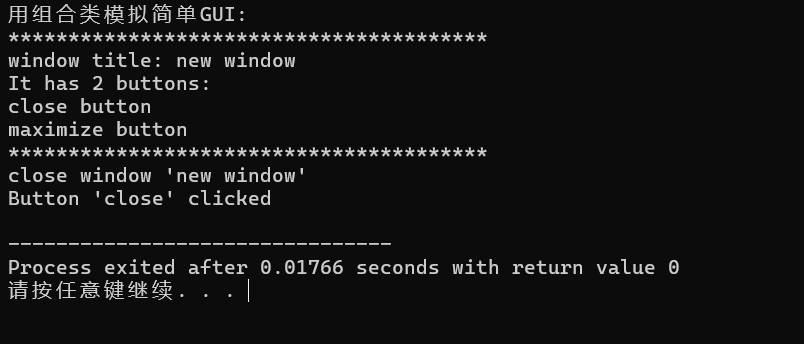
回答问题
问题一:
自定义了两个类:Button和Window。使用了标准库的vector。其中vector和button存在组合关系。
问题二:
1. const 成员函数
const成员函数是指不会修改类的成员变量的函数。要判断一个成员函数是否适合加const,可以考虑以下几点:
(1)只读访问:如果函数只读取成员变量而不修改它们,那么这个函数可以被声明为const
(2)逻辑上的不变性:即使函数内部不直接修改成员变量,但如果它调用了其他可能修改状态的函数,就不应该加const。
(3)接口设计:将访问器函数声明为const是一个良好的实践,因为这表明它不会改变对象的状态。
2. inline 成员函数
inline成员函数是提示编译器在调用该函数时插入函数体,以减少函数调用的开销。判断一个成员函数是否适合加inline的标准包括:
(1)小而简单的函数:如果函数的实现非常简单,将其声明为inline可能会带来性能提升。
(2)频繁调用的函数:如果某个函数在代码中被频繁调用,加inline可以减少函数调用的开销。
问题三:
line28的作用是:打印一行长度为40,字符元素都为 '*' 的字符串作为UI的分隔线。
2、实验任务2
task2.cpp
1 #include <iostream> 2 #include <vector> 3 4 using namespace std; 5 6 void output1(const vector<int> &v) { 7 for(auto &i: v) 8 cout << i << ", "; 9 cout << "\b\b \n"; 10 } 11 12 void output2(const vector<vector<int>> v) { 13 for(auto &i: v) { 14 for(auto &j: i) 15 cout << j << ", "; 16 cout << "\b\b \n"; 17 } 18 } 19 20 void test1() { 21 vector<int> v1(5, 42); 22 const vector<int> v2(v1); 23 24 v1.at(0) = -999; 25 cout << "v1: "; output1(v1); 26 cout << "v2: "; output1(v2); 27 cout << "v1.at(0) = " << v1.at(0) << endl; 28 cout << "v2.at(0) = " << v2.at(0) << endl; 29 } 30 31 void test2() { 32 vector<vector<int>> v1{{1, 2, 3}, {4, 5, 6, 7}}; 33 const vector<vector<int>> v2(v1); 34 35 v1.at(0).push_back(-999); 36 cout << "v1: \n"; output2(v1); 37 cout << "v2: \n"; output2(v2); 38 39 vector<int> t1 = v1.at(0); 40 cout << t1.at(t1.size()-1) << endl; 41 42 const vector<int> t2 = v2.at(0); 43 cout << t2.at(t2.size()-1) << endl; 44 } 45 46 int main() { 47 cout << "测试1:\n"; 48 test1(); 49 50 cout << "\n测试2:\n"; 51 test2(); 52 }
测试结果截图
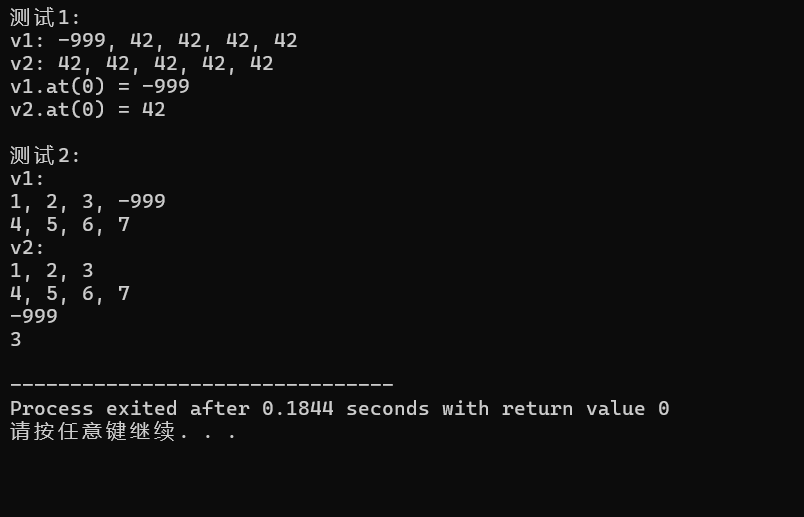
回答问题
问题一:
1. vector<int> v1(5, 42);
这一行创建了一个名为 v1 的 std::vector<int> 对象,初始化为包含 5 个元素,每个元素的值都是 42。
2. const vector<int> v2(v1);
这一行创建了一个名为 v2 的 std::vector<int> 对象,使用 v1 的内容进行初始化。由于 v2 被声明为 const,因此它是一个常量对象,不能被修改。
3. v1.at(0) = -999;
这一行使用 at 方法访问 v1 中的第一个元素(索引为 0),并将其值修改为 -999。
问题二:
1. vector<vector<int>> v1{{1, 2, 3}, {4, 5, 6, 7}};
v1 是一个 std::vector 的容器,其中包含两个子向量。第一个子向量包含元素 {1, 2, 3},第二个子向量包含元素 {4, 5, 6, 7}。
2. const vector<vector<int>> v2(v1);
这一行创建了一个名为 v2 的 std::vector<vector<int>> 对象,使用 v1 的内容进行初始化。由于 v2 被声明为 const,因此它是一个常量对象,不能被修改。
3. v1.at(0).push_back(-999);
这一行使用 at 方法访问 v1 中的第一个一维向量(索引为 0),并将 -999 添加到该向量的末尾。
问题三:
1. vector<int> t1 = v1.at(0);
这一行使用 at 方法从 v1 中获取第一个子向量(索引为 0),并将其赋值给 t1,t1 的内容将是 {1, 2, 3, -999}。
2. cout << t1.at(t1.size()-1) << endl;
这一行使用 at 方法访问 t1 的最后一个元素,同时会打印出 -999。
3. const vector<int> t2 = v2.at(0);
这一行从 v2 中获取第一个子向量(索引为 0),并将其赋值给 t2。但由于 t2 是常量,它的内容不能被修改。
4. cout << t2.at(t2.size()-1) << endl;
这一行使用 at 方法访问 t2 的最后一个元素,同时会打印出 3。
问题四:
①在 C++ 的标准库中,std::vector 的复制构造函数实现机制是深复制。这意味着在使用复制构造函数时,会创建一个新的 std::vector 实例,其中的元素是原始 std::vector 中元素的副本。
②std::vector 的 at() 方法确实至少需要提供一个 const 成员函数,以便支持对常量对象的安全访问。
3、实验任务3
1 #pragma once 2 3 #include <iostream> 4 #include <cassert> 5 6 using std::cout; 7 using std::endl; 8 9 // 动态int数组对象类 10 class vectorInt{ 11 public: 12 vectorInt(int n); 13 vectorInt(int n, int value); 14 vectorInt(const vectorInt &vi); 15 ~vectorInt(); 16 17 int& at(int index); 18 const int& at(int index) const; 19 20 vectorInt& assign(const vectorInt &v); 21 int get_size() const; 22 23 private: 24 int size; 25 int *ptr; // ptr指向包含size个int的数组 26 }; 27 28 vectorInt::vectorInt(int n): size{n}, ptr{new int[size]} { 29 } 30 31 vectorInt::vectorInt(int n, int value): size{n}, ptr{new int[size]} { 32 for(auto i = 0; i < size; ++i) 33 ptr[i] = value; 34 } 35 36 vectorInt::vectorInt(const vectorInt &vi): size{vi.size}, ptr{new int[size]} { 37 for(auto i = 0; i < size; ++i) 38 ptr[i] = vi.ptr[i]; 39 } 40 41 vectorInt::~vectorInt() { 42 delete [] ptr; 43 } 44 45 const int& vectorInt::at(int index) const { 46 assert(index >= 0 && index < size); 47 48 return ptr[index]; 49 } 50 51 int& vectorInt::at(int index) { 52 assert(index >= 0 && index < size); 53 54 return ptr[index]; 55 } 56 57 vectorInt& vectorInt::assign(const vectorInt &v) { 58 delete[] ptr; // 释放对象中ptr原来指向的资源 59 60 size = v.size; 61 ptr = new int[size]; 62 63 for(int i = 0; i < size; ++i) 64 ptr[i] = v.ptr[i]; 65 66 return *this; 67 } 68 69 int vectorInt::get_size() const { 70 return size; 71 }
1 #include "vectorInt.hpp" 2 #include <iostream> 3 4 using std::cin; 5 using std::cout; 6 7 void output(const vectorInt &vi) { 8 for(auto i = 0; i < vi.get_size(); ++i) 9 cout << vi.at(i) << ", "; 10 cout << "\b\b \n"; 11 } 12 13 14 void test1() { 15 int n; 16 cout << "Enter n: "; 17 cin >> n; 18 19 vectorInt x1(n); 20 for(auto i = 0; i < n; ++i) 21 x1.at(i) = i*i; 22 cout << "x1: "; output(x1); 23 24 vectorInt x2(n, 42); 25 vectorInt x3(x2); 26 x2.at(0) = -999; 27 cout << "x2: "; output(x2); 28 cout << "x3: "; output(x3); 29 } 30 31 void test2() { 32 const vectorInt x(5, 42); 33 vectorInt y(10, 0); 34 35 cout << "y: "; output(y); 36 y.assign(x); 37 cout << "y: "; output(y); 38 39 cout << "x.at(0) = " << x.at(0) << endl; 40 cout << "y.at(0) = " << y.at(0) << endl; 41 } 42 43 int main() { 44 cout << "测试1: \n"; 45 test1(); 46 47 cout << "\n测试2: \n"; 48 test2(); 49 }
测试结果截图
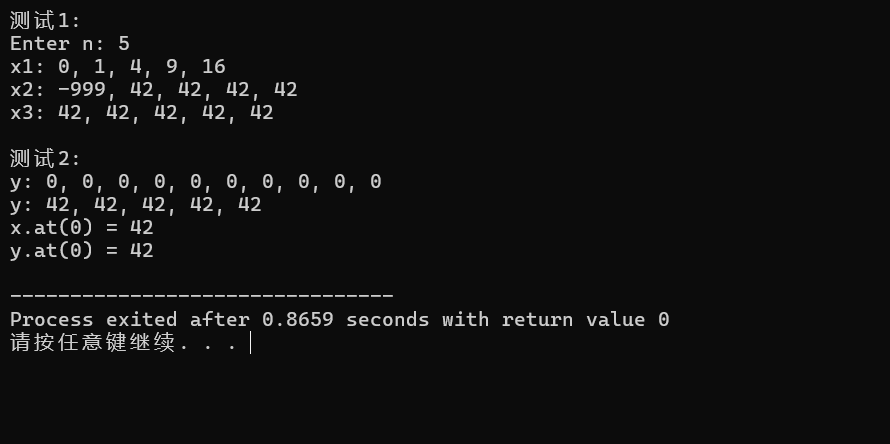
回答问题
问题一:
问题二:
问题三:
虽然可以将 assign() 的返回值类型改为 vectorInt,但这样做会导致性能下降,不支持链式调用,并可能引入额外的复杂性。在大多数情况下,保持 assign() 的返回值类 型为 vectorInt& 更为合理,能够提供更好的性能和灵活性。
4、实验任务4
1 #pragma once 2 3 #include <iostream> 4 #include <cassert> 5 6 using std::cout; 7 using std::endl; 8 9 // 类Matrix的声明 10 class Matrix { 11 public: 12 Matrix(int n, int m); // 构造函数,构造一个n*m的矩阵, 初始值为value 13 Matrix(int n); // 构造函数,构造一个n*n的矩阵, 初始值为value 14 Matrix(const Matrix &x); // 复制构造函数, 使用已有的矩阵X构造 15 ~Matrix(); 16 17 void set(const double *pvalue); // 用pvalue指向的连续内存块数据按行为矩阵赋值 18 void clear(); // 把矩阵对象的值置0 19 20 const double& at(int i, int j) const; // 返回矩阵对象索引(i,j)的元素const引用 21 double& at(int i, int j); // 返回矩阵对象索引(i,j)的元素引用 22 23 int get_lines() const; // 返回矩阵对象行数 24 int get_cols() const; // 返回矩阵对象列数 25 26 void display() const; // 按行显示矩阵对象元素值 27 28 private: 29 int lines; // 矩阵对象内元素行数 30 int cols; // 矩阵对象内元素列数 31 double *ptr; 32 }; 33 34 Matrix::Matrix(int n, int m) : lines(n), cols(m) { 35 ptr = new double[lines * cols](); 36 } 37 38 39 Matrix::Matrix(int n) : Matrix(n, n) {} 40 41 Matrix::Matrix(const Matrix &x) : lines(x.lines), cols(x.cols) { 42 ptr = new double[lines * cols]; 43 for (int i = 0; i < lines * cols; ++i) { 44 ptr[i] = x.ptr[i]; 45 } 46 } 47 48 Matrix::~Matrix() { 49 delete[] ptr; 50 } 51 52 void Matrix::set(const double *pvalue) { 53 for (int i = 0; i < lines; ++i) { 54 for (int j = 0; j < cols; ++j) { 55 at(i, j) = pvalue[i * cols + j]; 56 } 57 } 58 } 59 60 void Matrix::clear() { 61 for (int i = 0; i < lines * cols; ++i) { 62 ptr[i] = 0.0; 63 } 64 } 65 66 const double& Matrix::at(int i, int j) const { 67 assert(i >= 0 && i < lines && j >= 0 && j < cols); 68 return ptr[i * cols + j]; 69 } 70 71 double& Matrix::at(int i, int j) { 72 assert(i >= 0 && i < lines && j >= 0 && j < cols); 73 return ptr[i * cols + j]; 74 } 75 76 int Matrix::get_lines() const { 77 return lines; 78 } 79 80 81 int Matrix::get_cols() const { 82 return cols; 83 } 84 85 void Matrix::display() const { 86 for (int i = 0; i < lines; ++i) { 87 for (int j = 0; j < cols - 1; ++j) { 88 cout << at(i, j) << ", "; 89 } 90 cout << at(i,cols - 1); 91 cout << endl; 92 } 93 }
1 #include "matrix.hpp" 2 #include <iostream> 3 #include <cassert> 4 5 using std::cin; 6 using std::cout; 7 using std::endl; 8 9 10 const int N = 1000; 11 12 // 输出矩阵对象索引为index所在行的所有元素 13 void output(const Matrix &m, int index) { 14 assert(index >= 0 && index < m.get_lines()); 15 16 for(auto j = 0; j < m.get_cols(); ++j) 17 cout << m.at(index, j) << ", "; 18 cout << "\b\b \n"; 19 } 20 21 22 void test1() { 23 double x[1000] = {1, 1, 4, 5, 1, 4, 1, 9, 1, 9, 8, 10 }; 24 25 int n, m; 26 cout << "Enter n and m: "; 27 cin >> n >> m; 28 29 Matrix m1(n, m); // 创建矩阵对象m1, 大小n×m 30 m1.set(x); // 用一维数组x的值按行为矩阵m1赋值 31 32 Matrix m2(m, n); // 创建矩阵对象m1, 大小m×n 33 m2.set(x); // 用一维数组x的值按行为矩阵m1赋值 34 35 Matrix m3(2); // 创建一个2×2矩阵对象 36 m3.set(x); // 用一维数组x的值按行为矩阵m4赋值 37 38 cout << "矩阵对象m1: \n"; m1.display(); cout << endl; 39 cout << "矩阵对象m2: \n"; m2.display(); cout << endl; 40 cout << "矩阵对象m3: \n"; m3.display(); cout << endl; 41 } 42 43 void test2() { 44 Matrix m1(2, 3); 45 m1.clear(); 46 47 const Matrix m2(m1); 48 m1.at(0, 0) = -999; 49 50 cout << "m1.at(0, 0) = " << m1.at(0, 0) << endl; 51 cout << "m2.at(0, 0) = " << m2.at(0, 0) << endl; 52 cout << "矩阵对象m1第0行: "; output(m1, 0); 53 cout << "矩阵对象m2第0行: "; output(m2, 0); 54 } 55 56 int main() { 57 cout << "测试1: \n"; 58 test1(); 59 60 cout << "测试2: \n"; 61 test2(); 62 }
测试结果截图
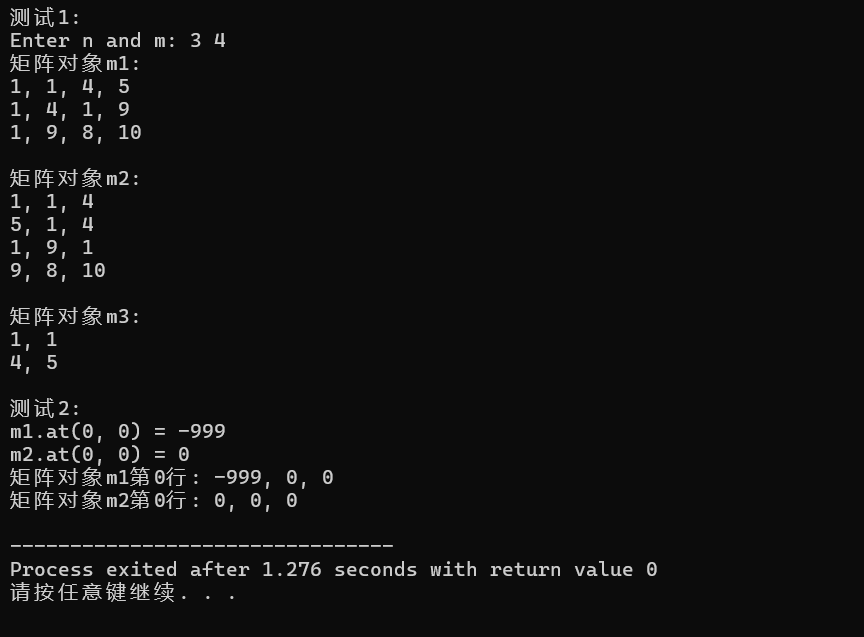
5、实验任务5
1 #ifndef USER_HPP 2 #define USER_HPP 3 4 #include <iostream> 5 #include <string> 6 #include <limits> 7 8 class User { 9 private: 10 std::string name; 11 std::string password; 12 std::string email; 13 14 public: 15 16 User(const std::string &name) 17 : name(name), password("123456"), email("") {} 18 19 20 User(const std::string &name, const std::string &password, const std::string &email) 21 : name(name), password(password), email(email) {} 22 23 24 void set_email() { 25 std::string input_email; 26 int ok = 1; 27 while (true) { 28 if(ok == 1){ 29 std::cout << "Enter email address: "; 30 } 31 std::cin >> input_email; 32 if (input_email.find('@') != std::string::npos) { 33 email = input_email; 34 std::cout << "Email is set successfully..." << std::endl; 35 break; 36 } else { 37 std::cout << "illegal email. Please re-enter email:"; 38 ok = 0; 39 } 40 } 41 } 42 43 44 void change_password() { 45 std::string old_password; 46 int attempts = 0; 47 int ok = 1; 48 49 while (attempts < 3) { 50 if(ok == 1){ 51 std::cout << "Enter old password: "; 52 } 53 std::cin >> old_password; 54 55 if (old_password == password) { 56 std::cout << "Enter new password: "; 57 std::string new_password; 58 std::cin >> new_password; 59 password = new_password; 60 std::cout << "new password is set successfully..." << std::endl; 61 return; 62 } else { 63 attempts++; 64 if(attempts < 3){ 65 std::cout << "Password input error. Please re-enter again: " ; 66 } 67 ok = 0; 68 } 69 } 70 std::cout << "Password input error. Please try after a while." << std::endl; 71 } 72 73 74 void display() const { 75 std::cout << "Username: " << name << std::endl; 76 std::cout << "Password: " << std::string(password.length(), '*') << std::endl; 77 std::cout << "Email: " << email << std::endl; 78 } 79 }; 80 81 #endif
1 #include "user.hpp" 2 #include <iostream> 3 #include <vector> 4 #include <string> 5 6 using std::cin; 7 using std::cout; 8 using std::endl; 9 using std::vector; 10 using std::string; 11 12 void test() { 13 vector<User> user_lst; 14 15 User u1("Alice", "2024113", "Alice@hotmail.com"); 16 user_lst.push_back(u1); 17 cout << endl; 18 19 User u2("Bob"); 20 u2.set_email(); 21 u2.change_password(); 22 user_lst.push_back(u2); 23 cout << endl; 24 25 User u3("Hellen"); 26 u3.set_email(); 27 u3.change_password(); 28 user_lst.push_back(u3); 29 cout << endl; 30 31 cout << "There are " << user_lst.size() << " users. they are: " << endl; 32 for(auto &i: user_lst) { 33 i.display(); 34 cout << endl; 35 } 36 } 37 38 int main() { 39 test(); 40 }
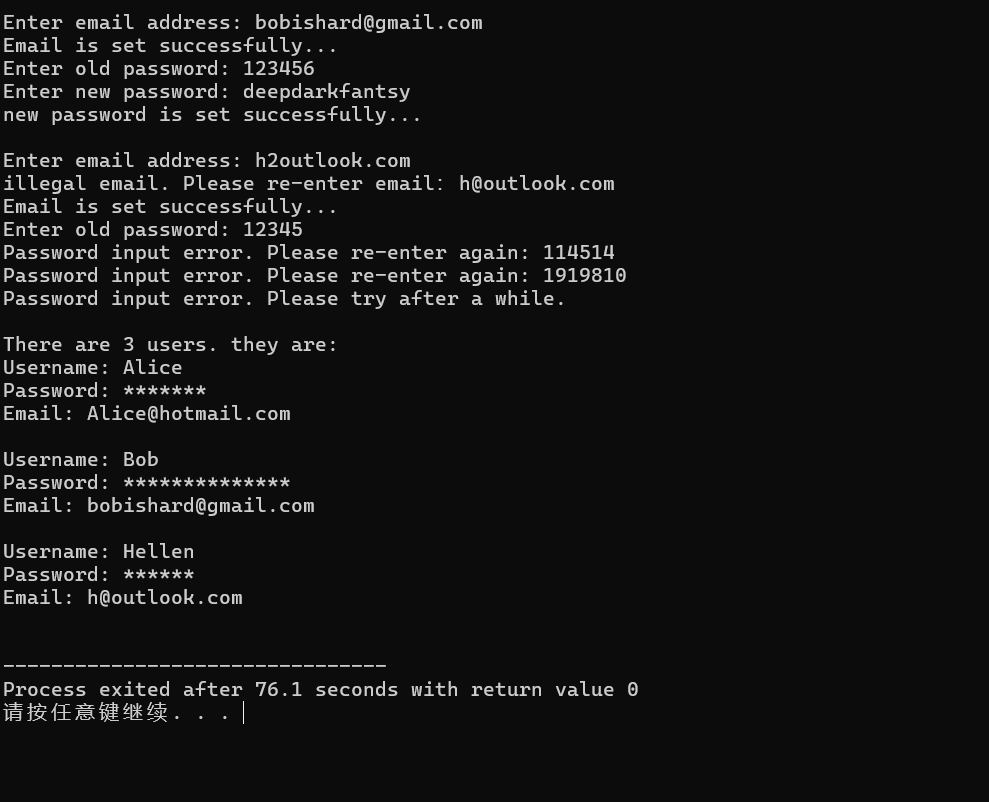
6、实验任务6
1 1 #pragma once 2 2 class Date { 3 3 private: 4 4 int year; 5 5 int month; 6 6 int day; 7 7 int totalDays; 8 8 public: 9 9 Date(int year, int month, int day); 10 10 int getYear()const { return year; } 11 11 int getMonth()const { return month; } 12 12 int getDay()const { return day; } 13 13 int getMaxDay()const; 14 14 bool isLeapYear()const { 15 15 return year % 4 == 0 && year % 100 != 0 || year % 400 == 0; 16 16 } 17 17 void show() const; 18 18 int distance(const Date& date)const { 19 19 return totalDays - date.totalDays; 20 20 } 21 21 }; 22 22 23 23 24 24 25 25 #include"date.h" 26 26 #include<iostream> 27 27 #include<cstdlib> 28 28 using namespace std; 29 29 namespace { 30 30 const int DAYS_BEFIRE_MONTH[] = { 0,31,59,90,120,151,181,212,243,273,304 ,334,365 }; 31 31 } 32 32 Date::Date(int year, int month, int day) :year(year), month(month), day(day) { 33 33 if (day <= 0 || day > getMaxDay()) { 34 34 cout << "Invalid date: "; 35 35 show(); 36 36 cout << endl; 37 37 exit(1); 38 38 } 39 39 int years = year - 1; 40 40 totalDays = years * 365 + years / 4 - years / 100 + years / 400 + DAYS_BEFIRE_MONTH[month - 1] + day; 41 41 if (isLeapYear() && month > 2) totalDays++; 42 42 } 43 43 int Date::getMaxDay()const { 44 44 if (isLeapYear() &&month == 2) 45 45 return 29; 46 46 else return DAYS_BEFIRE_MONTH[month] - DAYS_BEFIRE_MONTH[month - 1]; 47 47 } 48 48 void Date::show()const { 49 49 cout << getYear() << "-" << getMonth() << "-" << getDay(); 50 50 } 51 51 52 52 53 53 54 54 #pragma once 55 55 #include"date.h" 56 56 #include<string> 57 57 using namespace std; 58 58 class SavingsAccount { 59 59 private: 60 60 string id; 61 61 double balance; 62 62 double rate; 63 63 Date lastDate; 64 64 double accumulation; 65 65 static double total; 66 66 void record(const Date& date, double amount, const string& desc); 67 67 void error(const string& msg) const; 68 68 double accumulate(const Date& date)const { 69 69 return accumulation + balance * date.distance(lastDate); 70 70 } 71 71 public: 72 72 SavingsAccount(const Date& date, const string& id, double rate); 73 73 const string& getId()const { return id; } 74 74 double getBalance()const { return balance; } 75 75 double getRate()const { return rate; } 76 76 static double getTotal() { return total; } 77 77 void deposit(const Date& date, double amount, const string& desc); 78 78 void withdraw(const Date& date, double amount, const string& desc); 79 79 void settle(const Date& date); 80 80 void show() const; 81 81 }; 82 82 83 83 84 84 85 85 #include"account.h" 86 86 #include<cmath> 87 87 #include<iostream> 88 88 using namespace std; 89 89 double SavingsAccount::total = 0; 90 90 SavingsAccount::SavingsAccount(const Date& date, const string& id, double rate) : 91 91 id(id), balance(0), rate(rate), lastDate(date), accumulation(0) { 92 92 date.show(); 93 93 cout << "\t#" << id << "created" << endl; 94 94 } 95 95 void SavingsAccount::record(const Date& date, double amount, const string& desc) { 96 96 accumulation = accumulate(date); 97 97 lastDate = date; 98 98 amount = floor(amount * 100 + 0.5) / 100; 99 99 balance += amount; 100 100 total += amount; 101 101 date.show(); 102 102 cout << "\t#" << id << "\t" << amount << "\t" << balance << "\t" << desc << endl; 103 103 } 104 104 void SavingsAccount::error(const string& msg) const { 105 105 cout << "Error(#" << id << "):" << msg << endl; 106 106 } 107 107 void SavingsAccount::deposit(const Date& date, double amount, const string& desc) { 108 108 record(date, amount, desc); 109 109 } 110 110 void SavingsAccount::withdraw(const Date& date, double amount, const string& desc) { 111 111 if (amount > getBalance()) 112 112 error("not enough money"); 113 113 else 114 114 record(date, -amount, desc); 115 115 } 116 116 void SavingsAccount::settle(const Date& date) { 117 117 double interest = accumulate(date) * rate / date.distance(Date(date.getYear() - 1, 1, 1)); 118 118 if (interest != 0) record( date,interest,"interest" ); 119 119 accumulation = 0; 120 120 } 121 121 void SavingsAccount::show()const { 122 122 cout << id << "\tBalance: " << balance; 123 123 } 124 124 125 125 126 126 #include"account.h" 127 127 #include<iostream> 128 128 using namespace std; 129 129 int main() { 130 130 Date date{ 2008,11,1 }; 131 131 SavingsAccount accounts[] = { 132 132 SavingsAccount(date,"03755217",0.015), 133 133 SavingsAccount(date,"02342342",0.015) 134 134 }; 135 135 const int n = sizeof(accounts) / sizeof(SavingsAccount); 136 136 accounts[0].deposit(Date(2008, 11, 5), 5000, "salary"); 137 137 accounts[1].deposit(Date(2008, 11, 25), 10000, "sell stock 0323"); 138 138 accounts[0].deposit(Date(2008, 12, 5), 5500, "salary"); 139 139 accounts[1].withdraw(Date(2008, 12, 20), 4000, "buy a laptop"); 140 140 cout << endl; 141 141 for (int i = 0; i < n; i++) { 142 142 accounts[i].settle(Date(2009, 1, 1)); 143 143 accounts[i].show(); 144 144 cout << endl; 145 145 } 146 146 cout << "Total: " << SavingsAccount::getTotal() << endl; 147 147 return 0; 148 148 } 149 150 task6




